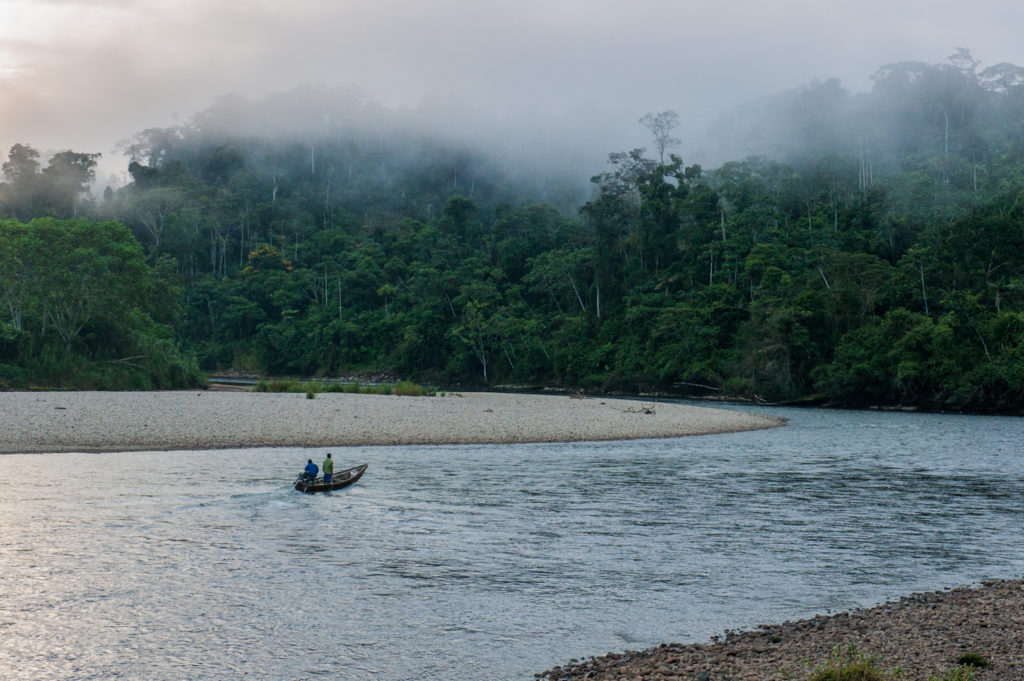
Words and photo by Beth Wald
In a little-known corner of southeast Ecuador lies a low range of cloud-cloaked mountains called the Cordillera del Condor. Steep, forested slopes and clean-running rivers support a dizzying array of bird, plant, animal, and fish life. Despite recent population growth, large tracts of the Condor remain unexplored.
“We don’t even know what marvels we have yet to discover in the Condor,” says Dr. Juan Guayasamin, a biologist, who discovered several new species of frogs during a 2006 scientific expedition to the Condor.
The Cordillera del Condor is the ancestral home of the Shuar people, the legendary tribe of the Amazon, who were never conquered by the Spanish. For the Shuar, the thousands of waterfalls, streams, and springs in the Condor are sacred places and the source of healing, spiritual renewal, and life itself. The Shuar people still maintain many aspects of their traditional life, language, and culture among the forests and waters of the Condor. In this photo, dancers wait to perform in a community at the headwaters of the Nangaritza River.
Shuar in the Condor depend on subsistence farming and fishing, so a healthy environment and clean water are critical to both their physical and cultural survival.
But this pristine beauty, natural bounty, and biological and cultural diversity are gravely threatened by a series of large-scale gold and copper mines that are being developed along the spine of the Condor range. The first large-scale mine in the history of Ecuador is an open-pit copper mine. This Mirador Mine is being built by a Chinese corporation in the northern corner of Zamora-Chinchipe Province.
Pristine forest is being cleared to make way for the Mirador Copper Mine. The pit will be about a mile across and about half a mile deep. It will generate 600 million tons of potentially toxic waste that will be stored on nearby steep slopes and in tailings impoundments next to the Quimi River—only 1 kilometer from the village of Tundayme.
Communities like Kumpiamais close to the Mirador Mine, as well as provincial leaders and environmental groups, are worried about negative impacts the mine could have on the environment. But they have received little credible information and do not trust the environmental assessment done by the company. Ecuador has no experience evaluating and regulating large-scale mine projects. Outside experts such as E-Tech International have found problems with the design of the Mirador Mine and inadequacies in its Environmental Impact Statement. Considering the Condor’s receives 160 inches of rain each year and the fact that the mine, waste piles, and toxic tailings will be located very near water sources, experts say there is a significant risk that local streams and rivers will be contaminated.
Despite hopes that the development of mining in the Condor will bring jobs, most of the employment will be temporary and unskilled; the higher-paying engineering and technical jobs go to Chinese workers or to Ecuadoreans from outside the Condor.
Although there are people who welcome large-scale mining, the majority of Shuar and Saraguro are opposed to the Mirador and other proposed large-scale mines. Leaders say that their people have not been consulted about or given their consent to the mine projects, which is a violation under national and international law. (The Ecuadorean constitution, as well as international agreements signed by Ecuador, including the United Nations Declaration on the Rights of Indigenous Peoples, guarantee that indigenous people will be allowed “free, prior and informed consent” before the development of extractive projects in their territories.)
“We were never consulted,” says Domingo Ankuash, a Shuar leader from Kumpiamais. “Meeting with a few Shuar inviduals and telling them about the mine is not a substitute for consultation. It has to be ‘free, prior, and informed,’ and involve all the people in the community. Otherwise it doesn’t work.”
Global Greengrants Fund has helped Shuar and other indigenous communities, including the Centro Shuar Kumpiamais, organize so that they may confront these threats. Communities have used grants to educate themselves on the risks of the mine projects, to reinforce ancient traditions and culture, and to work towards a truly sustainable economy for the region based on agriculture, tourism, and non-extractive industries.
The Condor region provides a bounty of fruit—bananas, plantain, papaya, and mangos—as well as yucca, corn, coffee, peanuts, and other products that, given a healthy environment, will provide stable source of food for local communities and can be sustainably managed and exported within Ecuador and abroad. Many people in the Condor wish to develop such livelihoods as an alternative to mining.
“The Condor probably contains the largest number of endemic species in the country,” says Ecuadorean biologist Dr. Juan Guayasamin, who says that the large swathes of still pristine forest in the Condor should be revered and protected as part of Ecuador’s natural and cultural heritage.
